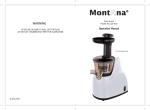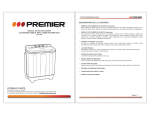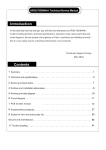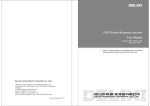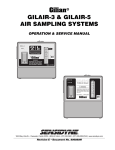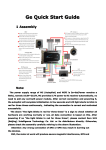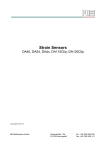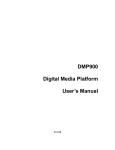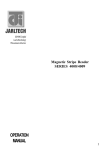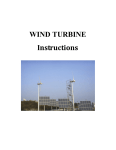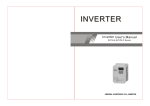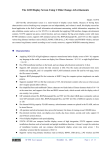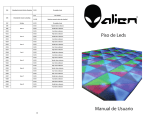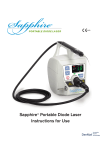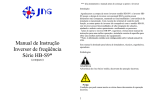Download 前 言
Transcript
Foreword Foreword Thanks for purchasing frequency converter of CDI9100-S series manufactured by Delixi (Hangzhou) Inverter Co., Ltd. For ensuring correct application of the device, please read the manual carefully before operates it. Incorrect application should cause abnormal operation, fault, decrease service life, even cause body injures. The manual belongs to standard accessory; please keep it carefully for further reference. Besides operating instruction, the manual also provide user with connection diagram in purpose of reference. Please contact agent, or Customer Center of our Company for any difficulty or special requirement. The manual includes operating instruction relating to CDI9100-S series converter with power level of 0.4KW~1.5KW. While the Company could modify content in it without any early information. Please confirm following content during unpackaging: 1. If the product is damaged during process of transportation, if parts are damaged and dropped, or if main body is bruised. 2. If rated value marked on nameplate is consistent with your order requirement, or if there are ordered unit, acceptance certificate, operation manual and guarantee shed in package. The Company strictly complies with quality system during production and packaging, for any inspection miss, please contact our Company or supplier for settlement. People should not reprint, transmit, and use the manual or content relating to it without written permission of the Company, who will assume legal responsibility for damage caused in violation of the item. Page I Contents Contents Section One Safe operation and precautions........................................................................... 1 Section Two Product information ........................................................................................... 2 2.1 Nameplate data and naming rule...................................................................................... 2 2.2 Technical specification of CDI9100-S series converter ................................................... 3 2.3 CDI9100-S series converter............................................................................................. 4 2.4 Appearance and installation dimension............................................................................ 5 2.5 Routine maintenance ....................................................................................................... 6 Section Three Installation and connection of converter.......................................................... 8 3.1 Installation of front cover and number keyboard ............................................................. 8 3.2 Selection of installing position ........................................................................................ 8 3.3 Connection of main loop and the precautions.................................................................. 9 3.4 Connection of control circuit ......................................................................................... 10 3.4.1 Terminal arrangement and connection diagram of control circuit......................... 10 3.4.2 Function of control circuit termina ........................................................................ l2 3.5 Grounding...................................................................................................................... 13 Section Four Keyboard operation and running ..................................................................... 14 4.1 Selection of operating mode .......................................................................................... 14 4.2 Test run and inspection .................................................................................................. 14 4.3 Operating method of keyboard ...................................................................................... 15 4.3.1 Keystroke and function......................................................................................... 15 4.3.2 Display method of keyboard................................................................................. 16 4.3.3 Method of “check/set parameter” (via number keyboard) .................................... 17 4.3.4 Frequency setting of keyboard.............................................................................. 18 Section Five Functional parameter sheet .............................................................................. 19 Section Six Description of function parameter ................................................................... 26 6.1 Sort P00 Basic function parameter ................................................................................ 26 6.2 Sort P01 Secondary function parameter......................................................................... 33 6.3 Sort P02-Input/output terminal and multi-speed running function ................................ 37 6.4 Sort P03 Other function parameter ................................................................................ 46 6.5 Sort P04 Display functional parameter .......................................................................... 47 6.6 Sort P05 Factory parameter ........................................................................................... 47 Section Seven Fault recovery ............................................................................................... 48 7.1 Trouble shooting of motor ............................................................................................. 48 7.2 Fault diagnosis and recovery of converter. .................................................................... 49 Page II Section One Safe operation and precautions Section One Safe operation and precautions Please read the manual carefully before install, operate, maintain or check CDI9000-S series converter. For ensuring personal safety, device safety and property safety, please read the manual carefully before usage of the device. The precautions about safe operation can sort to “warning”or “be careful”. : Potentially dangerous condition, which maybe cause severe body injuries or dead if relevant requirement is ignored. Warning Note : Potentially dangerous condition, which maybe cause middle, light injuries or device damage if relevant requirement is ignored, it also applies to unsafe operation. Precautions for safe operation: 1. Installation and maintenance should be performed by professional only. 2. Verify if the rated voltage of converter is same as the AC power supply voltage 3. Do not make supply power of AC loop connect with outputting terminal U, V and W. The connection will damage converser, thus guarantee card sho8uld be nonserviceable. Warning 4. Please connect to input power supply only after assembled panel, and don’t disassemble external converter after electrified. 5. Do not touch high-voltage terminal in converter. 6. Do not connect or disconnect lead and connector if the circuit is electrified. 7. Do not touch CMOS element because the vulnerability of it. 8. Do not perform voltage test with the device. 1. Do not modify factory parameter of converter without authorization, or damage might be caused. 2. For converter of which storage period exceeds half year, please increase the input voltage gradually by using regulator, to prevent from electric shock and explosion. 3. To prevent from electric shock, please perform maintenance ten minutes after powerdown, and check if charging indicator crushed out completely, or voltage at positive and negative bus is lower than 36V. Note 4. All parts should be replaced by professional only. It is strictly prohibitive to remain stub or metal object in machine, to prevent from fire. 5. After replaced control board, please perform relevant parameter setting before operation to prevent from damage of materials. Page 1 Section Two Product information Section Two Product information 2.1 Nameplate data and naming rule Nameplate data: Take Type CDI9100-S-G0R7T2 as an example: Nameplate data CDI 9100-S G Type description 0R7 T2 Delixi converter Design number Series number G: General type P: Pump type ZS: Injection Moulding type GS: Isobaric water supply system GY: Intelligent machine Power of equipped electromotor (KW) 0R4=0.4KW 0R7=0.75KW 1R5=1.5KW Page 2 Voltage class (rated voltage): T2=200V-230V T4=380-415V T6=660-690V T11=1140V Section Two Product information 2.2 Technical specification of CDI9100-S series Control mode Frequency Resolution Control Operation Frequency accuracy V/F rate Torque compensation Operating mode Frequency setting Starting signal Multiple stage speed Acceleration Input and signal deceleration time Emergency stop Inching motion Automatic operation Fault reset Running state Output Fault output signal Analog output Running function Converter protection Protective function Instantaneous powerdown Display Key board Environment Cooling mode Running information Error information Ambient temperature Storage temperature Ambient humidity Height/vibration Application position Control of space voltage vector Digital : 0.01 Hz, Analog: 0.05 Hz / 50 Hz, Output frequency range: 0–400Hz Digital: 0.01 % of peak output frequency Analog: 0.1 % of peak output frequency Linear, square root, random V/F Manual torque compensation (0 - 30 %) Key board/ terminal Analog: VF terminal, IF terminal Digital: Key board Corotation, reversion Up to eight speed is allowable (by using multiple function terminal) 0.1-3600 second, acceleration and deceleration time is switchable, Type: linear Interrupt output of converter. Idle operation Operate automatically according to parameter set (7 stage speed) Reset fault state automatically if protective function is effective Frequency inspection class, overload alarm, over voltage, under voltage, overheat, running, stop, constant speed, automatic program running Contact output: AC250V 1A, DC 30V 1A FM output: 0 - 10V DC brake, frequency limit, slip compensation, reversion protection etc. Over voltage, module fault protection, under voltage, overheat, fault protection. Lower than 15 msec: Continuous operation Bigger than 15 msec: Automatic restart is allowable Set frequency, output frequency, output voltage, bus voltage, input signal, feedback value, module temperature. Running state of fault protection, four fault information are saved. -10 ℃ ~ 40 ℃ -20 ℃ ~ 65 ℃ 90 % RH in max .(no dewing) Below 1,000 m, below 5.9m/sec²(=0.6g) No corrosive gas, inflammable gas, oil mist, dust and others Air-blast cooling Page 3 Section Two Product information 2.3 CDI9100-S series converter Type Rated voltage Rated power Rated output current Motor CDI9100-S-G0R4T2 200-230v 0.4KW 2A 0.4KW CDI9100-S-G0R7T2 200-230v 0.75kW 4A 0.75kW CDI9100-S-G1R5T2 200-230v 1.5kW 7A 1.5kW Order explanation: During order, please enter type, specification of the product, and provide parameter, load type, or other information relating to the motor as much as possible. For any special requirement, please consult with technology department of the Company. Page 4 Section Two Product information 2.4 Appearance and installation dimension 型 号 CDI9100-S-0R4T2 CDI9100-S-0R7T2 CDI9100-S-1R5T2 W W1 H H1 D D1 ¢d 100 91 150 142 116 72 5 Note:Terminal sequence should base on actual object Page 5 Section Two Product information 2.5 Routine maintenance (1) Routine maintenance Under influence of temperature, humidity, dust and vibration, internal elements of converter should be aged, which should cause potential fault, or decrease service life of converter. Therefore, it is significant to perform routine maintenance and regular inspection with the converter. Routine maintenance item: A If running sound of motor is abnormal. B If vibration is created during operation of motor. C If installing condition of converter is changed. D If radiating fan of converter works normally. E If converter is in state of overheat. Daily cleanness: A Keep cleanness of converter. B Remove dust from surface of converter effectively, to prevent converter from incursion of dust, or metal dust. C Remove oil sludge form radiating fan of converter effectively. (2) Regular inspection Please inspect corner pockets of converter regularly. Regular inspection item: A Inspect air flue, and clean it regularly. B Inspect if screw is loosened. C Inspect if converter is corrosive. D Inspect if there is arc on surface connecting terminal. E Insulated test of major loop Note: Please disconnect major loop and converter while testing insulation resistance by using megohmmeter (500V DC megohmmeter). Do not measure insulation of control loop with megohmmeter. And high voltage test is needless (finished in ex works). (3) Replacement of wearing parts Wearing parts of converter includes cooling fan, filter ELCC, of which service life depend on operating environment and maintenance condition closely. User could confirm replacement period according to the operating time. A Cooling fan Potential damage reason: Shaft abrasion and vane aging. Critical standard: If there is crack on vane of fan, or if abnormal sound occurs during starting. B Filter ELCC Potential damage reason: Bad input power, higher ambient temperature, frequent load switch, or aging of electrolyte. Critical standard: If liquid leaks, if safety valve bulged out, measure of static capacitance, and measure of insulated resistance. (4) Storage of converter After purchased the device, please pay attention to following points while storing it: A Please store it in original package as much as possible. B Long term storage should cause aging of ELCC, please electrify it for 5 hours above twice a year during storing, in mode of raising voltage to rated voltage slowly via transformer. (5) Guarantee of converter Maintenance free is limited to the converter only. For fault or damage occurs during normal application of device sold in home (delivery date): A Perform guaranteed repair, guaranteed exchange, guaranteed return in one month after delivery. Page 6 Section Two Product information B C Perform guaranteed repair, guaranteed exchange in three months after delivery. And perform guaranteed repair in 15 months after delivery. For exported device (not included China), the Company should provide guaranteed repair in six months after delivery at purchase site. For products manufactured by the Company, we will provide paid service for life anytime, or anywhere applied it. All sale, product, and agent units of the Company should provide products with after sale service, of which service terms include: A Provide “Class Ⅲ” inspection service at site of the unit. (Include fault elimination) B Refer to after sell service contract concluded between the Company and agents. C Request for compensated after-sell service from agent of the Company (without reference to guaranteed repair). Our Company should take responsibility of guaranteed repair, guaranteed exchange, and guaranteed return for quality and accident responsibility relating to the product, but user could affect insurance for further responsibility compensation guarantee from insurance agent. Guarantee term of the product should be effective in 15 months after delivery. For fault caused in following reason, user could obtain compensated maintenance only even guarantee term is effective: A Problem caused in incorrect operation (based on user’s manual) or repair, modification without authorization. B Problem caused in violation of critical requirement. C Damage caused in undeserved transportation after purchased. D Aging or fault caused in bad environment. E Damage caused in earthquake, fire, disaster, lightning strike, abnormal voltage or other natural disaster and incidental disaster. F Damage occurs in transportation. (Note: transportation mode should be appointed by user of themselves, the Company should assist agent to conduct transfer of goods). G Brand, trade mark, SN, nameplate marked by manufacturer is damaged or unjustifiable. H Failure to pay off fund according to purchase contract. I Failure to describe actual conditions relating to installation, distribution, operation, maintenance, or other condition to the Company. The Company should carry out responsibility of “Three guarantee” abovementioned only after received the returned goods, and confirmed responsibility attribution. Should it involve an unpaid or untimely settlement due to the buyer, the ownership hereof still belongs to the supplier. In addition, the latter will assume no liability hereinabove, and the buyer shall have no disagreement. All relevant service fees shall be calculated in accordance with the identical standards of the factory. In the event that an agreement or a contract exist, its priority shall be performed. Page 7 Section Three Installation and connection of converter Section Three Installation and connection of converter 3.1 Installation of front cover and number keyboard 1. Installation of front cover 1. Raise unit body by propping the seat; do not hold front cover and raise the unit while moving it. Otherwise main body maybe fall down and cause body injure. 2. Please install converter onto nonflammable materials (for example: Metal). Violation of the rule maybe causes fire. Warning 3. Please install a fan or other cooling device if installed device in a cabinet, of which inlet temperature should be lower than 40℃. Overheat maybe causes fire or damages the device. This Section describes the necessary construction, setting condition, and space required by installation of CDI9100-S series converter. It is needless to take down front cover and manipulater for general installation. Please disassemble manipulater carefully because it connects with internal circuit via cables. Pull out cable before assemble manipulater and panel, or plug should be damaged. 2. Installation of number keyboard Please disassemble and reassemble number keyboard according to following method: A Disassemble number keyboard: Press lock clasp of number keyboard and take out it from front cover. B Reassemble number keyboard: Press number keyboard into keyboard frame of panel, the lock clasp should lock number keyboard automatically. 3.2 Selection of installing position Selection of installing position: 1. Prevent from sunniness; Don’t use in the open air directly. 2. Don’t use in the corrosive gas and liquid environment. 3. Don’t use in the oil fog and splash environment. Warning 4. Don’t use in the salt spray environment. 5. Don’t use in the moist and rain environment. 6. Please equip the unit with filters device if metal dust or fiber wadding existing in air. 7. Do not use the unit in mechanical shock or vibration condition. 8. It is necessary to adopt cooling measure if ambient temperature is higher than 40℃. 9. It is recommended to use the unit in temperature range of -10℃~+40℃ because fault maybe occur in overcool or overheat condition. 10. Keep the unit away from power supply noise, high-power application, such as electric welder should impact application of the unit. 11. Emissive material should impact application of the unit. 12. Keep the unit away from combustible material, attenuant and solvent. For ensuring perfect performance and long-term service life, please comply abovementioned advices while installing CDI9100-S series converter to prevent the unit from damage. Page 8 Section Three Installation and connection of converter 3.3 Connection of main loop and the precautions The Chapter describes connection of main loop of CDI9100-S series converter. 1. Do not make power supply of AC main loop connect with output terminal U, V, and W. 2. Please connect unit only after shut down the power supply. 3. Verify if the crating voltage of converter is same as the input voltage of it. Dangerous 4. Do not perform withstand test with converter. 5. Fasten terminal screw with appointed fasten torque. 1. Please check if grounding terminal is grounded before connect main loop. (Refer to 3.5) 2. Terminal sequence should base on actual object. 3. Rated input voltage: AC single-phase220V Frequency: 50/60Hz Note 4. Allowable fluctuation voltage: 10~ - 15% (fluctuation ±20%) Frequency: ±2% Connection of 0.4-1.5KW main loop of CDI9100-S series: Note:Terminal sequence should base on actual object Page 9 Section Three Installation and connection of converter 3.4 Connection of control circuit 3.4.1 Terminal arrangement and connection diagram of control circuit Following figure is connection diagram of main loop and control loop. It is possible to run the motor only after connected main loop if number keyboard is used. Page 10 Section Three Installation and connection of converter Note: 1. For control terminal, frequency setting and monitor instrument, shielding wire or twisted pair wire required (wiring in ellipse). 2. It is possible to select voltage or current input of main support frequency via parameter of P02.09 or P02.10, and select terminal control via parameter of P02.00-P02.06. 3. Maximal output current of 10V (+10V) control loop terminal is 50mA. 4. Multi-function analog output is used for monitoring instruction (such as output frequency meter, current meter etc.), while not be used for feeding back control system. 5. COM and GND are common terminal of I/O signal and analog signal, please not connect or ground these common terminals mutually. 6. For prevent from interfere, please distributing control loop apart from main loop and heavy current loop (relay contact, 220V program loop). 7. Input switch of external terminal (except relay contact) is passive input signal, power input maybe damage the converter. 8. For prevent from failure action caused in noise interfere, please deleave lead of control circuit apart from lead of main loop and other power cable. Connection of control circuit adopts twisted wire or double twisting wire, via which connect external shielding case to grounding terminal of converter in distance of 50m below. 9. In the block chart, J1 is switch, of which functions include: J1is used for selecting current/voltage signal input for IF or VF channel. J1 switch locate at side I while selecting current input, while locate at side V while selecting voltage input. 10. J2 is BI switch, of which functions include: J2 is used for selecting current/voltage signal output for FM channel. J2 locate at side I while selecting current output, while locate at side V while selecting voltage output. Page 11 Section Three Installation and connection of converter 3.4.2 Function of control circuit terminal: Following sheet summarize function of control circuit terminal, which is connected according to function respectively. Sort Terminal Signal function Description Signal level FWD Run/stop in positive Run in positive MF contact input, Photoelectric MF direction direction while set via input coupler insulation signal closing, and stop P02.01~P02.04 Input: ON/OFF while opening. Internal 24VDC/8mA REV Run/stop in reversal Run in reversal direction direction while closing, and stop while opening. D1 Multi-speed Become effective command 1 after closed D2 Multi-speed Become effective command 2 after closed D3 Multi-speed Become effective command 3 after closed D4 Three-wire running Become effective control after closed COM MF common input terminal Analog 10V +10V power output +10V power supply of analog command. +10V input Maximum allowed signal current 20mA VF Analog output 0~+10V/100% P02.09 and P02.10 0~ +10V (20KΩ) voltage seeting IF Analog output 0/4~20mA/100% 0/4~20mA (250Ω) current GND Common ground of analog signal P24 Power supply of External power Output between digital signal supply is provided COM DC24V, 200mA in max. TA Fault indicator Close during P02.06=10 Contact capability (NO/NC contact) operation 250VAC, 1A or TB below TC P24 Power supply of External power Output between MF digital signal supply is provided COM DC24V, output 200mA in max. signal TA Fault indicator Close during P02.06=10 Contact capability (NO/NC contact) operation 250VAC, 1A or TB below TC Analog FM Frequency meter 0 ~ +10V/frequency Output 0~+10V output output Fmax. Load 2mA or below signal Page 12 Section Three Installation and connection of converter 3.5 Grounding 1. Grounding resistance value: 200V level: 100Ω or value below it. 2. Do not ground CDI9100-S series converter with common grounding of heavy current devices, such as electric welder, electric motor etc. Depart grounding wire in guide pipe from lead of other heavy current devices. 3. Please use approved grounding wire of which length should be as shorter as possible. 4. Please ground devices according to figure (a) if several CDI9100-S converters are used in series; do not loop grounding wire in mode shown in figure (c). 5. Please connect grounding wire of CDI9100-S converter and the motor as shown as figure (d). (a) Correct (d)Correct (b) Incorrect (c) Non-recommended (e)Non-recommended 6. Connection inspection: Please perform following items if installation and connection are completed. A If connection is correct. B If stub or screw remains in device. C If screws are fastened firmly. D If bare conductor on terminal contacts with other terminals. Page 13 Section Four Keyboard operation and running Section Four Keyboard operation and running 4.1 Selection of operating mode CDI9100-S series converter provides two control modes of keyboard operation and terminal operation, via which user could select and use relevant control mode according to local environment and operating requirement. For details, please refer to description of parameter P00.00. 4.2 Test run and inspection 1. Precautions and inspection before test run For ensuring operation safety, please relieve mechanical connector before first operation to separate motor from mechanical equipment and prevent from dangerous. Please perform following inspection before test run: A If connection between lead and terminal is correct. B If lead thrum cause short circuit. C If screw terminal is fastened firmly. D If motor is installed firmly. 2. Test run After preparation, connect to power supply and inspect if frequency converter works normally. After connected to power supply, indicator of number keyboard is luminous. Please cut off power supply immediately if any problem abovementioned occurs. 3. Operating inspection Please verify following items during operation: A If motor rotates smoothly. B If rotation direction of motor is correct. C If abnormal vibration or noise occurs accompanying with operation of motor. D If acceleration and deceleration are smooth. E If current match with load value. F If LED state indicator and number keyboard displays correctly. Page 14 Section Four Keyboard operation and running 4.3 Operating method of keyboard. 4.3.1 Keystroke and function Installation dimension of operating keyboard Indicator Function 36mm*70mm No. Name 1 FOR Chinese Name Corotation 2 REV Reverse 3 RUN Run 4 STOP Stop Function Description Corotation Indicator, When corotation it is light, reverse it is.not light.. Reverse.Indicator, When Reverse it is light, corotation it is not light. When the converter is running, it is light. When the converter is stopping, it is light. Page 15 Section Four Keyboard operation and running 4.3.2 Display method of keyboard 1. Monitor mode of running information It is possible to check current state information of converter by press >> if monitor mode is run. 2. Fault/alarm monitor mode A In state of running monitor, the unit should display information relating to fault and warning if fault and alarm occurs. B Reset fault by press STOP/RESET if fault disappears. C Please cut off power supply and reset the unit if serious fault occurs. D Keyboard should display fault code continuously until fault is eliminated (refer to Section Seven). 3. Parameter setting method Converter parameter and inspection on running state of converter are settable. Please adjust parameter value properly to obtain perfect running state. Page 16 Section Four Keyboard operation and running 4.3.3 Method of “check/set parameter” (via number keyboard) Note: It is possible to increase or decrease value step by step by press △,▽ while modifying function code of parameter P, and move it in cooperation of >> after enter into parameter setting. And it is impossible to modify data under following conditions. 1. It is impossible to adjust parameter during operation of converter. (Refer to function sheet) 2. Start protective function in P03.04 (write protection). Page 17 Section Four Keyboard operation and running 4.3.4 Frequency setting of keyboard It is possible to set frequency via mode of number keyboard and keyboard POT, which should be selected by modifying parameter P00.01. 1. Set frequency via number keyboard directly A Set value of parameter P00.01 as 1. B Enter into frequency setting by pressing △, ▽ during operation of converter; C Adjust frequency to required value by pressing △, ▽, for example: 48.00Hz. D After adjustment, the set frequency should be saved into parameter P00.02 automatically. E Press MODE to return to parameter setting, and press MODE again to return running monitor mode. F It is possible to modify frequency setting value during operation only. 2. Set frequency via keyboard POT Firstly, set value of P00.01as 0, and adjust frequency to required value by rotating POT knob on keyboard rightwards or leftwards, of which setting value should not be saved to P00.02 automatically. Page 18 Section Five Functional parameter sheet Section Five Functional parameter sheet Description 1. According to the function, functional parameter of CDI9100-S common converter could be divided into four sorts, which includes several function code of different value. In keyboard operation, parameter sort corresponds to Level 1 menu, function code corresponds to Level 2 menu, and setting value of function code corresponds to Level 3 menu. 2. P××.×× in function sheet or other section of the manual denotes “××” function code of sort “××”; For example, “P00.01” denotes 01 function code of sort P00. 3. Content explanation of function sheet: List 1 “Sort”: name and SN of function parameter team; List 2 “function code”: SN of function code parameter; List 3 “Name”: complete name of function parameter; List 4 “setting range”: effective setting value range of function parameter; List 5 “Minimal unit”: minimal unit of setting value of function parameter; List 6 “Factory setting”: factory setting value of function parameter; List 7 “modification limit”: modification property of function parameter (if modification is allowable, and the condition); List 8 “reference page”:reference page number of function parameter. Modification limit of parameter is explained as following: “○” denotes setting value of the parameter is modifiable in state of stop or running; “×” denotes setting value of the parameter is nonmodifiable (set in factory) in running state. Explanation: 1. Please read the manual carefully while modifying parameter of converter. And contact our Company for any problem occurs during operation. No data submits to customer modification, violation of it maybe causes serious fault, or significant property loss, of which consequences should be born by User! 2. It denotes user’s operation is error if “d.Err” displayed on LED. Page 19 Section Five Functional parameter sheet Sort 5.1 Sort P00-Basic function parameter Function Name Setting range code P00.00 Selection of 0: Panel control RUN/STOP operation control 1: Operation control of external terminal mode 2: Host control Basic P00.01 Setting mode 0: Keyboard POT function selection of 1: Number setting 2: Terminal VF operation parameter 3: Terminal IF frequency 4: Number keyboard+ analog terminal 5: VF+IF 6: UP/DOWN Control mode 1 of increase/decrease terminal 7: UP/DOWN Control mode 2 of increase/decrease terminal 8: Control mode 1 of external pulse 9: Control mode 2 of external pulse P00.02 Keyboard 0.00 ~ maximum frequency frequency setting P00.03 Running direction 0: Corotation controlled via 1: Reversion panel P00.04 Maximum 50.00~400.0Hz frequency P00.05 Rated motor 25.00~maximum frequency frequency P00.06 Rated motor 200~450V voltage P00.07 V/F curve mode 0: Linear 1: Square 1 2: Square 2 3: Double broken line P00.08 Torque offset 0~30% voltage P00.09 Middle voltage 0~100% P00.10 Middle frequency 0~Rated motor frequency P00.11 Acceleration time 0.1~3600S 1 P00.12 Deceleration time 0.1~3600S 1 P00.13 Upper frequency Lower frequency limit ~ limit maximum frequency P00.14 Lower frequency 0.00~upper frequency limit limit P00.15 Stop mode of 0 Stop lower frequency 1 Run limit Page 20 Min. unit Factory setting 1 0 Modification Reference limit 26 × 1 0 × 0.01Hz 50.00Hz ○ 1 0 0.01Hz 50.00Hz × 0.01Hz 50.00Hz × 1V 220V × 1 0 × 1% 3% × 30 1% 0.01Hz 0.1S 50% × 25Hz × Type(*1) ○ 31 0.1S Type(*1) ○ 0.01Hz 50.00Hz ○ 0.01Hz 0.00Hz ○ 1 0 × 29 ○ 32 Section Five Functional parameter sheet 5.2 Sort Secondary function parameter Sort P01-secondary function parameter Function code P01.00 Name Setting range Startup frequency 0.00~10.00Hz P01.01 Startup frequency Holding time Stop mode 0.0~10.0S P01.02 P01.03 P01.04 P01.05 P01.06 P01.07 P01.08 P01.09 P01.10 P01.11 P01.12 P01.13 P01.14 P01.15 P01.16 P01.17 P01.18 P01.19 P01.20 P01.21 P01.22 P01.23 Original frequency of DC powerdown DC brake voltage of powerdown DC brake time of powerdown Dead zone time Stopping mode selection of ambient fault Function of power on Waiting time of power on Waiting time of fault recovery Fault recovery frequency Offset frequency Frequency setting gain Inch frequency setting Acceleration time of inch frequency Deceleration time of inch frequency Acceleration time 2 Deceleration time 2 Acceleration time 3 Deceleration time 3 Acceleration time 4 Deceleration time 4 UP/DOWN setting frequency Min. unit 0.01H z 0.1S Factory setting 0.00Hz Modification limit ○ 0.0S ○ 1 0 × 0.00Hz × 0~15% 0.01H z 1% 0% × 0.0~20.0S 0.1S 0.0S × 0.0~20.0S 0: Unforced stop 1: Powerdown mode 0: No action 1: Act 0.1~20.0S 0.1S 1 0.0S 1 ○ ○ 1 0 × 0.1S 2.0S × 1~60S 1S 5S × 0~3 1 3 × -50.0~+50.0Hz 1~200% 0.1Hz 1% 0.0Hz 100% × × 0.1~50.00Hz 2.00Hz ○ 0.1~60.0S 0.01H z 0.1S 1.0S ○ 0.1~60.0S 0.1S 1.0S ○ 0.1~3600S 0.1~3600S 0.1~3600S 0.1~3600S 0.1~3600S 0.1~3600S 0.01~2.50 Hz/S 0.1S 0.1S 0.1S 0.1S 0.1S 0.1S 0.01H z/S 1.0S 1.0S 1.0S 1.0S 1.0S 1.0S 1.0Hz/S ○ ○ ○ ○ ○ ○ × 0: Decelerating stop 1: Unforced stop 0.00~10.00Hz Reference 33 34 35 36 Page 21 Section Five Functional parameter sheet 5.3 Sort P02-input/output terminal and multiple-speed running parameter Sort Function Name code input/output P02.00 Running control terminal mode selection of External terminal. And multiple- P02.01 D1 speed terminal function running parameter P02.02 D2 terminal function Setting range 0: 1: 2: 0: 1: 2: 3: 4: 5: 6: 7: 8: 9: 10: 11: P02.03 D3 terminal function 12: 13: 14: Dual-wire control mode 1 Dual-wire control mode 2 Three-wire control-self-hold Unused Multiplex frequency terminal 1 Multiplex frequency terminal 2 Multiplex frequency terminal 3 Inch control of corotation Inch control of reversion Three-wire running control Acceleration time /deceleration time terminal 1 Acceleration/deceleration time terminal 2 Free parking input External reset input Frequency up(UP) Frequency down (Down) DC brake control NORM OPEN input of external fault NORM CLOSR input of external fault PLC running pause instruction 15: P02.04 D4 16: Terminal function P02.05 Not set(set aside) 0: Running signal of converter 1: Frequency arriving signal 2: Frequency level inspection signal 3: Overload alarm signal 4: Stoppage caused in external fault 5: Stoppage caused P02.06 Functional undervoltage selection 6: Output frequency achieves of relay to upper limit output 7: Output frequency achieves terminal to lower limit 8: Programmable multi-speed running is finished. 9: Running in Zero speed 10: Fault display P02.07 Frequency 0.00~10.00HZ achieves inspection width 0.00~maximum frequency P02.08 Frequency level signal inspection Page 22 Min. Factory Modificatio Refere unit setting n limit nce 1 0 × 37 1 1 × 1 2 × 1 3 × 1 6 × 38 41 1 10 × 0.01 2.50Hz ○ Hz 0.01 10.00H ○ Hz z 42 Section Five Functional parameter sheet Function Name code P02.09 Analog quantity input terminal VF selection P02.10 Analog quantity input terminal IF selection P02.11 Secondary adjustment volume setting. P02.12 Feed channel selection of secondary volume. P02.13 Analog output setting P02.14 Progra P02.15 mmable multipl e-speed running P02.16 P02.17 P02.18 P02.19 P02.20 P02.21 P02.22 P02.23 P02.24 P02.25 P02.26 P02.27 P02.28 P02.29 P02.30 P02.31 Setting range Min. Factory Modifica Refer unit setting tion limit ence 43 1 0 × 0: 0~10V/0~20mA 1: 10~0V/20~0mA 2: 0~5V/0~10mA 3: 5~0V/10~20mA 4: 2~10V/4~20mA 5: 10~2V/20~4mA 1.0%~20.0% 1 0.1% 1.0% × 0: 1 0 × 1 0 ○ VF 1: IF 0: Output frequency 1: Output voltage Analog output gain 0.50~2.00 Programmable 0: No action multiple-speed running 1: Single cycle setting (simple PLC 2: Continuous cycle running) 3: Hold final value Running frequency in stage Lower frequency 1 limit~upper frequency limit Running direction in stage 0: Corotation 1 1: Reversion Running time of stage 1 0.0~3600S Acceleration and 1~4 deceleration time in stage 1 Running frequency in stage Lower frequency 4 limit~Upper frequency limit Running direction in stage 0: Corotation 2 1: Reversion Running time of stage 2 0.0~3600S Acceleration and 1~4 deceleration time in stage 2 Running frequency in stage Lower frequency 4 limit~Upper frequency limit Running direction in stage 0: Corotation 3 1: Reversion Running time of stage 3 0.0~3600S Acceleration and 1~4 deceleration time in stage 3 Running frequency in stage Lower frequency 4 limit~Upper frequency limit Running direction in stage 0: Corotation 4 1: Reversion Running time of stage 4 0.0~3600S Acceleration and 1~4 deceleration time in stage 4 0 0.01 1.00 1 0 × ○ × 44 45 0.01 5.00Hz ○ Hz 1 0 ○ 0.1S 10.0S ○ 1 1 ○ 46 0.01 10.00H ○ Hz z 1 0 ○ 0.1S 10.0S ○ 1 1 ○ 0.01 15.00H ○ Hz z 1 0 ○ 0.1S 10.0S ○ 1 1 ○ 0.01 20.00H ○ Hz z 1 0 ○ 0.1S 10.0S ○ 1 1 ○ Page 23 Section Five Functional parameter sheet Function Name code P02.32 Running frequency in stage 5 P02.33 Running direction in stage 5 P02.34 Running time of stage 5 P02.35 Acceleration and deceleration time in stage 5 P02.36 Running frequency in stage 6 P02.37 Running direction in stage 6 P02.38 Running time of stage 6 P02.39 Acceleration and deceleration time in stage 6 P02.40 Running frequency in stage 7 P02.41 Running direction in stage 7 P02.42 Running time of stage 7 P02.43 Acceleration and deceleration time in stage 7 5.4 Setting range Min. unit Lower frequency limit ~ 0.01 Hz Upper frequency limit 0: Corotation 1 1: Reversion 0.1S 0.0~3600S 1 1~4 Factory Modifica Refere setting tion limit nce 46 30.00Hz ○ 0 ○ 10.0S 1 ○ ○ Lower frequency limit ~ Upper frequency limit 0: Corotation 1: Reversion 0.0~3600S 1~4 0.01 40.00Hz ○ Hz 1 0 ○ Lower frequency limit ~ Upper frequency limit 0: Corotation 1: Reversion 0.0~3600S 1~4 0.01 50.00Hz ○ Hz 1 0 ○ 0.1S 10.0S 1 1 0.1S 10.0S 1 1 ○ ○ ○ ○ Sort P03-other function parameter Sort Function Name code Advanced P03.00 CF application adjustment P03.01 Reversion protection P03.02 Display factor setting P03.03 Monitor contentof LED P03.04 Parameter input protection P03.05 Parameter initialization Page 24 Setting range 1~12KHz 0: No action 1: Act 0.1~200.0 Min. Factory Modification Reference unit setting limit 46 1KHzType × (*2) 1 0 × 0.1 0:Output frequency 1: Setting 1 frequency 2:Output voltage 3:Bus voltage 4:Input signal 5:Feedback value display 6: Module temperature 1 0: All data are alterable 1:Only P00.02 and the function are alterable 2: Only the function is alterable 1 0: No action 1: Eliminate fault record 2: Reset (Remark:Function 2 should be displayed 5 seconds after pressed continuously) 1.0 ○ 0 ○ 0 ○ 0 × 47 Section Five Functional parameter sheet 5.5 Sort P04-Display function parameter Sort Function code Name P04.00 Output frequency Setting frequency Output voltage Bus voltage Input signal Feedback value display Module temperature Cumulative operation time 1st fault record 2nd fault record 3rd fault record fault 4th record P04.01 P04.02 P04.03 P04.04 P04.05 P04.06 P04.07 P04.08 P04.09 P04.10 P04.11 5.6 Sort Setting range Min. unit Factory setting Modification limit Reference Hz * 47 Hz * V * V Hz * * * ℃ * Hour * * * * * Sort P05-Factory parameter Function code P05.00 Name Factory password input Setting range **** Minimm unit Factory setting Modification limit - Refer ence 47 Page 25 Section Six Description of function parameter Section Six Description of function parameter 6.1 Basic function parameter Sort P00 Function code Name Setting range Unit Factory Modified Selection of 0 Panel control RUN/STOP operation 1 Operation control of external terminal 1 0 × control mode 2 Host control For connecting mode of operation command control of external terminal, please refer to Chapter 3.5 and description relating to P02.00~P02.06 of Sort P02. Function Name Setting range Unit Factory Modified code 1 0 × P00.01 Setting mode 0 Keyboard POT selection of 1 Number setting 2 Terminal VF running 3 Terminal IF frequency 4 Number keyboard + analog terminal 5 VF+IF 6 Control mode 1 of raising /down going terminal 7 Control mode 2 of raising /down going terminal 8 Control mode 1 of terminal pulse 9 Control mode 2 of terminal pulse 0: It is possible to set running frequency via potentiometer on operating panel in state of running or power down. 1: Under running state of converter, user could modify setting frequency via△, ▽ on panel directly, and save modified value into P00.02 automatically to renovate current frequency of converter (noneffective during power down). Under running or powerdown state, current frequency should be modified accompanying with modification of value of P00.02. 2: Control of Terminal VF VF 为 is voltage signal input channel, of which seven kinds of analog signal input range are optional. User could confirm corresponding relation between VF input voltage range and setting frequency via modifying parameter of P02.09 function code. Under this frequency setting mode, VF is used for individual frequency setting. 3: IF terminal control IFis voltage/current signal input channel, of which seven kinds of signal input range are optional. User could confirm corresponding relation between IF input voltage range and setting frequency via modifying parameter of P02.10 function code. Under this frequency setting mode, IF is used for individual frequency setting. 4: Number keyboard+analog terminal control Under the mode, digital setting value of P00.02 function code is used as primary setting, while setting value of one analog signal input of these two analog signal channel is used as secondary setting, and summation of these two values is used as current setting frequency of converter. These two setting values should be summarized only, if the setting mode is selected. Under the setting mode, user could modify the part set via P00.02 function code (digital setting value of current setting frequency) by using △,▽, confirm the setting value and save it into P00.02 by pressing key of ENTER Under running or powerdown state, digital setting value should be renovated if value of P00.02 is changed. Under the setting mode, user needs to set this part set by analog signal via adjusting value of P02.09~P02.12 according to actual condition. For analog signal used as secondary setting, user could achieve secondary setting value by multiplying frequency value of P02.09or P02.10 with value of P02.11 5: VF+IF control Page 26 P00.00 Section Six Description of function parameter Under the setting mode, user could set frequency of current converter via input of these two analog signal channels, confirm one of these two analog channel as primary setting value via value of parameter P02.12, confirm another analog channel as secondary setting value, and achieve current setting frequency by summarizing these two values. These two setting values should be summarized only, if the setting mode is selected. Frequency value between analog signal of primary setting and corresponding parameter P02.09 or P02.10. For analog signal used as secondary setting, user could achieve secondary setting value by multiplying frequency value of corresponding parameter P02.09 or P02.10 with value of parameter P02.11. Explanation: Under frequency setting mode of number keyboard+analog terminal and VF+IF: 1. In case that analog input signal of VF channel is ambipolar input, user could dispose it in mode of absolute value, which should not include diversion information. 2. IF selects voltage/current signal input according to position of JP2jumper on control board. If current input is selected, short-circuit block of JP2 jumper locate at side of I, and input resistance of the channel is 500Ω. 3. Under VF+IF frequency setting mode, one of these two analog channels is used as primary setting, and the other is used as secondary setting. Hereinto, one channel with no analog signal input is allowable, and setting another channel to setting frequency value according to value of P02.12 is allowable (set as secondary setting or primary setting). 4. In case that secondary setting channel is selected, user could achieve setting frequency of secondary setting by summarizing secondary adjusting frequency value with frequency value of primary setting. But the setting frequency is limited to upper frequency limit and lower frequency limit. 5. Under VF+IF frequency setting mode, is input, after input secondary setting signal by selected secondary setting channel (VF), system creates ambipolar secondary adjusting value (define as percent of maximal frequency setting value), which should create corresponding secondary adjusting frequency value to perform fine adjustment with setting frequency of primary setting. Relation among secondary setting, secondary adjusting volume, secondary adjusting frequency value created by input signal of secondary setting channel is shown as following sheet: Input signal of secondary Lower input signal value of Middle input signal value of Upper input signal value of secondary setting channel secondary setting channel secondary setting channel setting channel Secondary adjusting value Min. secondary adjusting Middle secondary adjusting value Max. secondary adjusting value value EX: set maximal frequency as 50 Hz; set input range of analog signal as 0 ~ 10 V; Set secondary adjusting value as 10 % (refer to function code of P02.16); Voltage setting signal, secondary adjusting value, secondary adjusting frequency value input via secondary setting channel are: 0 ~ 10 V 0V 5V 10 V 10% 10% 10 % 10 % Secondary adjusting 0 Hz 2.5 Hz 5 Hz frequency value. Page 27 Section Six Description of function parameter 6: Control mode 1 of up/down terminal Under the mode, user could set current frequency of converter via setting function of external control terminal. The connection diagram is shown as following if setting 6、7 via frequency setting mode Figure 6.1.1 Connection diagram of 6、7 frequency setting mode Relation between state setting of two external switches and current frequency of converter is shown as following sheet: Open/Close state of UP terminal Open Close Open/Close state of DOWN Open Close Open Close terminal Current frequency Hold Decrease continuously Increase continuously Hold (To lower frequency limit) (To upper frequency limit) Under the setting mode: Current setting frequency of converter is set to zero automatically every time after powerup. And converter sets current frequency as zero after received STOP and executed powerdown process. These two external terminals should be invalid in powerdown state or in process of powerdown. 7. Control mode 2 of up/down terminal The basic operation is same as Control mode 1 of up/down terminal, but differ from: Current setting frequency of converter is saved automatically during execution of powerdown command after received STOP, which is used as initial setting value of next operation. 8: Control mode 1 of terminal pulse Function of external terminal is defined as Control mode 1 of up/down terminal, but differ from: Connection diagram is shown as following if 8、 9 frequency setting mode is selection. Figure 6.1.2 Connection diagram of 8、 9 frequency setting mode Under the setting mode: setting frequency increases/decreases for one time each time after received a pulse signal, of which P01.23 setting value apart from time. Current frequency is set as zero automatically every time after powerup. And converter sets current frequency as zero after received STOP and executed powerdown process. These two external terminals should be invalid in powerdown state or in process of powerdown. Page 28 Section Six Description of function parameter 9. Control mode 2 of terminal pulse Setting frequency increases/decreases for one time each time after received a pulse signal, of which P01.23 setting value apart from time. The basic operation is same as Control mode 1 of up/down terminal, but differ from: Current setting frequency of converter is saved automatically during execution of powerdown command after received STOP, which is used as initial setting value of next operation. Explanation: 1. Under following operating mode, running frequency of converter apart from these ten frequency setting modes and frequency setting value abovementioned: Inch running frequency, multi-speed running frequency, and programmable multi-speed running Function code Name Setting range Unit Factory Modification Keyboard 0.00~upper frequency 0.01Hz 50.00Hz O frequency setting limit Panel control 0 Corotation P00.03 1 0 O Running direction 1 Reversion Upper frequency P00.04 50.00~400.0Hz 0.01Hz 50.00Hz × limit Rated frequency 25.00~ upper frequency P00.05 0.01Hz 50.00Hz × of motor limit Rated voltage of P00.06 100~450V 1V 220V × motor Upper frequency limit denotes upper allowable frequency output by converter, shown as Fmax in figure 6.1.7. Rated input voltage of motor is corresponding to voltage of motor running in rated frequency. Function Name Setting range Unit Factory Modification code V/Fcurve 0 linear 2 square 2 P00.07 1 0 × mode 1 square 1 3 double broken line mode In figure 6.1.3, figure 6.1.4, figure 6.1.5, and figure 6.1.6, curve 1 denotes V/F curve after plused torque offset voltage under respective V/F curve mode; and curve 2 denotes V/F curve without addition of offset voltage under respective V/F curve mode. P00.02 0: Linear mode Figure 6.1.3 Constant torque V/F curve Page 29 Section Six Description of function parameter 1: Square 1 mode Figure 6.1.4 Degressive torque mode 1 2: Square 2 mode Figure 6.1.5 Degressive torque mode 2 3: Double broken line mode User could custom V/F curve mode via setting parameter P00.09, P00.10, according to actual requirement. Figure 6.1.6 Broken line V/F curve Explanation: For general load, curve 0 is optional; for square torque equipment, such as pump, the curve 1 is optional. Function code Name Setting range Unit Factory Modification P00.08 Torque offset voltage 0~30% 1% 3% × For offsetting low frequency torque characteristic, system should raise output voltage in low frequency operating zone, shown as Vb in figure 6.1.3, Page 30 Section Six Description of function parameter Figure 6.1.4, Figure 6.1.5, and Figure 6.1.6. Explanation: In general condition, 3% of default value could meet requirement. For overcurrent fault occurs during starting up, please increase the parameter value from zero step by step until starting requirement is achieved. Do not raise parameter value at one moment to prevent from damage of equipment. Function Name Setting range Unit Factory Modification code P00.09 Middle voltage 0~100% 1% 50% × P00.10 Middle frequency 0~rated frequency of motor 0.01Hz 25.00Hz × Set middle voltage and middle frequency in any V/F curve required by user. And enter into broken line mode if parameter P00.07 is 3. Middle voltage is percent of rated voltage of motor, namely, Vm in Figure 6.1.6. Middle frequency is a frequency value between lower frequency limit and rated frequency of motor, namely, Fm in Figure 6.1.6. Function Name Setting range Unit Factory Modification code P00.11 Acceleration time 1 0.1~3600S 0.1S Type (*1) O P00.12 Deceleration time 1 0.1~3600S 0.1S Type (*1) O Acceleration time 1 denotes time required for raise to upper frequency limit from "forbid” state, namely, T1 in Figure 6.1.7. Deceleration time 1 denotes time required for decreasing maximal output frequency to “forbid” state, namely, T2 in Figure 6.1.7. Figure 6.1.7 Definition of acceleration time and deceleration time Following figure is switch process of acceleration time and deceleration time: Figure 6.1.8 Switch of acceleration time and deceleration time Page 31 Section Six Description of function parameter Function code Name Setting range Unit Factory Modification Upper frequency Lower frequency limit ~ 0.01Hz 50.00Hz O limit maximal frequency Lower frequency 0.00~Upper frequency P00.14 0.01Hz 0.00Hz O limit limit Upper frequency limit denotes maximal setting frequency allowed by user, namely, UF in figure 6.1.9. Lower frequency limit denotes minimal setting frequency allowed by user, namely, LF in figure 6.1.9. P00.13 Figure 6.1.9 Schematic diagram for definition of limit frequency parameter Explanation: 1. Please set maximal frequency, upper frequency limit, lower frequency limit carefully according to nameplate parameter and operating condition of controller motor. 2. Limited range of lower frequency limit and upper frequency limit are noneffective for operation of JOG. 3. Besides upper frequency limit, lower frequency limit, output frequency of converter is also limited by setting value of starting frequency, starting frequency of DC brake, and jump frequency. 4. Output frequency of converter should run with lower frequency limit if setting frequency is lower than lower frequency limit; Output frequency of converter should run with upper frequency limit if setting frequency is higher than upper frequency limit. Function code Name Setting range Unit Factory Modification Lower frequency limit 0 Stop P00.15 1 0 × Running mode 1 Run Page 32 Section Six Description of function parameter 6.2 Secondary function parameter Sort P01 Function code Name Setting range Unit Factory Modification Starting 0.00~10.00Hz 0.01Hz 0.00Hz O frequency Frequency function, switch converter into operating state from state of powerdown: running frequency in case of 1st powerup, power recovery after instantaneous power down, reset after fault, free stop, and normal stop etc. Function Name Setting range Unit Factory Modification code Starting frequency P01.01 0.0~10.0S 0.1S 0.0S O Holding time 0 Decelerative stop P01.02 Stop mode 1 0 × 1 Free stop 0: Decelerative stop Converter should perform decelerative stop according to preset deceleration time and mode via decreasing output frequency after received command of “STOP”. During decelerative stop, output frequency of converter should jump to zero if set frequency is lower than starting DC brake frequency (refer to P01.03); at this time, converter should perform DC brake and stop working after implement if function of DC brake is selected; or stop working directly. The mode is mainly used for general deceleration stop or condition that rapid brake is required (external brake resistance or brake unit is required). 1: Free stop mode (free running stop) Converter stop output immediately after received stop command; and motor stop freely with inertia. It is general to adopt external mechanical band brake to achieve rapid stop. Function Name Setting range Unit Factory Modification code Starting frequency P01.03 0.00~10.00Hz 0.01Hz 0.00Hz × of DC brake Starting frequency of DC brake: it denotes the transition point frequency of converter while abruptly drop output frequency to zero along with deceleration curve during process of deceleration and stop, namely, Fd in Figure 6.2.1. During deceleration and stop process, output frequency jump to zero while setting frequency is lower than starting frequency of DC brake, and deactivate DC brake function set by converter. Starting frequency of DC brake is effective in deceleration process while switching between corotation and reversion. If DC brake function is selected, the stopping frequency is starting frequency of DC brake. If no running condition offers strict requirement on stopping brake, please set starting frequency of DC brake as smaller as possible. Function code Name Setting range Unit Factory Modification P01.04 DC brake voltage 0~15% 1% 0% × P01.05 DC brake time 0.0~20.0S 0.1S 0.0S × DC brake time: time for output DC brake voltage during stopping process of converter. Explanation: Parameter of DC brake time is noneffective if DC brake with external terminal is selected. DC brake is noneffective if DC brake time is set as 0.0S, or DC brake voltage is set as 0%. P01.00 Page 33 Section Six Description of function parameter Function code Name Setting range Unit Factory Modification Dead time of corotation 0.0~20.0S 0.1S 0.0S O and reversion Dead time of corotation and reversion: it denotes waiting time and holding time of converter in process of decreasing output frequency to zero during direction switch after received reverse running command, shown as T0 in figure 6.2.1. P01.06 Figure 6.2.1 Dead time of corotation and reversion Function code Name Setting range Unit Factory Modification Stop mode selection of 0 Unforced stop 1 1 O external fault 1 Powerdown mode Explanation: 1. Stop in stopping mode denotes stop according to setting of P01.02. 2. Free stop denotes converter stop output after received stop command; and motor stop freely with inertia Function Name Setting range Unit Factory Modification code Power switch 0 No action P01.08 1 0 × function 1 Act 0: No action, forbid converter restarting motor after instant power failure or recovery of powerdown. 1: Act, allow converter automatically execute power switching function after instant power failure or recovery of powerdown. Explanation: In case that P01.08=1: under keyboard control mode, converter automatically executes power-switching function to recover power supply after powerdown and instant poweroff. Under control mode of external terminal, power-switching function should be noneffective if current combination state of FWD/REV is noneffective during power recovery after powerdown and instant poweroff. Function Name Setting range Unit Factory Modification code Waiting time for power P01.09 0.1~20.0S 0.1S 2.0S × switching function During waiting time for power switching function, motor should start up once running command is output. The time setting principle is mainly based on operation recovery time of devices relating to converter. P01.07 Page 34 Section Six Description of function parameter Function code Name Setting range Unit Factory Modification Waiting time for test recovery 1~60S 1S 5S × of fault. P01.11 Time for test recovery of fault. 0~3 1 3 × Converter stop outputting if fault occurs during operation; converter should reset fault automatically and go on running by setting reset interval via P01.10. Time of automatic reset is set via P01.11, which denotes allowable time of automatic reset before manual reset or electrifying operation of next time, namely, system should perform automatic reset before time parameter decreases to Zero, except manual reset or reset via reset signal of external terminal is executed. The parameter should recover to original setting value after manual reset or external terminal reset is executed. Function Name Setting range Unit Factory Modification code P01.12 Bias frequency -50.0 ~ +50.0Hz 0.1Hz 0.0Hz × It is possible to set output frequency via adjusting bias frequency P01.12 and frequency setting gain P01.13 under frequency setting of analog signal. Output frequency = analog signal×frequency setting gain+bias frequency. P01.10 Figure 6.2.2 Bias frequency Function Name Setting range Unit Factory Modification code P01.13 Frequency setting gain 1~200% 1% 100% × It denotes compensation while analog signal is lower than 5V/10/20mA. EX: it is possible to achieve 0~HF adjustment if frequency setting gain is 200%, no matter whether input signal achieve 2.5V/5V/12mA. Figure 6.2.3 Frequency setting gain Page 35 Section Six Description of function parameter Function Name Setting range Unit Factory Modification code P01.14 Inch frequency 0.1~50.00Hz 0.01Hz 2.00Hz O P01.15 Inch acceleration time 0.1~60.0S 0.1S 1.0S O P01.16 Inch deceleration time 0.1~60.0S 0.1S 1.0S O P01.14~P01.16 denotes parameter of inch running, shown as figure 6.2.4. In figure, ft is inch running frequency, t1 is inch acceleration time, t3 is inch deceleration time, t2 is inch running time, which is obtained via subtracting inch acceleration time from the time interval between effective and noneffective inch running command executed by panel or external terminal. User could perform inch running command via operating panel and control terminal. Figure 6.2.4 Inch running parameter Function code Name Setting range Unit Factory Modification P01.17 Acceleration time 2 0.1~3600S 0.1S 1.0S O P01.18 Deceleration time 2 0.1~3600S 0.1S 1.0S O P01.19 Acceleration time 3 0.1~3600S 0.1S 1.0S O P01.20 Deceleration time 3 0.1~3600S 0.1S 1.0S O P01.21 Acceleration time 4 0.1~3600S 0.1S 1.0S O P01.22 Deceleration time 4 0.1~3600S 0.1S 1.0S O User could select acceleration time/deceleration time 1, 2, 3, 4 (define acceleration time/deceleration time in P00.11、P00.12) as acceleration time/deceleration time in running process of converter via control terminal. As well as define them as acceleration time/deceleration time for frequency switching in each stage of simple PLC operation, please refer to function code P02.19、P02.23、P02.27、P02.31、P02.35、P02.39、P02.43 in P02 parameter sort. Function Name Setting range Unit Factory Modification code UP/DOWN P01.23 0.01 ~ 2.50 Hz/S 0.01Hz/S 1.0Hz/S × Setting speed Increase/decrease volume of setting frequency while setting frequency via UP/DOWN terminal. Increase/decrease volume of setting frequency while setting frequency via external pulse control, which is foreign to time. Page 36 Section Six Description of function parameter 6.3 Sort P02-Input/output terminal and multi-speed running function Function code Name Setting range Running control 0 Dual-wire control mode 1 selection of 1 Dual-wire control mode 2 P02.00 external 2 Three-wire control mode terminal 0: Dual-wire control mode 1 1: Unit Factory Modification 1 0 × Figure 6.3.1 Dual-wire control mode 1 Dual-wire control mode 2 Figure 6.3.2 Dual-wire control mode 2 2: Three-wire control mode—selfhold function Figure 6.3.3 Three-wire control mode Page 37 Section Six Description of function parameter In figure 6.3.3, SB1 is NC stop button, SB2 is NO running button, SB1 and SB2 is pulse edge effect; K is running direction button; Di is the terminal in D1~D4 defined as terminal of three-wire control mode (6). Function code Name Setting range Unit Factory Modification 0 Unused 1 Multi-speed terminal 1 D1 terminal 2 Multi-speed terminal 2 P02.01 1 1 × function 3 Multi-speed terminal 3 4 Inch control of corotation 5 Inch control of reversion 6 Three-wire control mode 7 Acceleration time/deceleration D2 terminal time terminal 1 P02.02 1 2 × function 8 Acceleration time/deceleration time terminal 2 9 Free stop input 10 External reset input 11 Progressive increase of D3 terminal frequency(up) P02.03 1 3 × function 12Decrease of frequency(down) 13 DC brake control 14 NO input of external fault D4 terminal 15 NC input of external fault 1 6 × P02.04 function 16 PLC pause D1~D4 control terminal is programmable switching value input terminal. User could define function of D1~D4 respectively via setting value of P02.01~P02.04, refer to sheet 1. EX: Function of terminal D1 is defined as “Free stop input command” if P02.01=9; it is possible to achieve function of free stop during operation if D2 is in state of ON. Explanation: A function is nonselectable after selected by a terminal, and programmable switching value input terminal could select Nonfunction only (set to 0 synchronously). 1~3: Multi-speed running terminal User needs to define three switch value input terminals as multi-speed running control terminal if Multi-speed running is selected; select a multi frequency set in P02.16, P02.20, P02.24, P02.28, P02.32, P02.36, P02.40 via combination state of ON/OFF of these three terminal, which has precedence over frequency set via frequency setting mode of P00.01; stage frequency selected by multi-speed running terminal is used as setting frequency of converter. Please refer to explanation relating to this. It is possible to achieve multi-speed control via external switch if P02.01=1, P02.02=2, P02.03=3, shown as figure 6.3.2. Page 38 Section Six Description of function parameter Figure 6.3.4 Connection diagram of multi-speed operation User could select multi-speed running frequency via combination of K1, K2, and K3 according to sheet 1, shown as figure 6.3.5. Figure 6.3.5 Schematic diagram of multi-speed operation K3 OFF Sheet 1 Multi-speed operation sheet K2 K1 Frequency setting OFF OFF No multi-frequency operation OFF OFF ON Multistage frequency 1(P02.16) OFF ON OFF Multistage frequency 2(P02.20) OFF ON ON Multistage frequency 3(P02.24) ON OFF OFF Multistage frequency 4(P02.28) ON OFF ON Multistage frequency 5(P02.32) ON ON OFF Multistage frequency 6(P02.36) ON ON ON Multistage frequency 7(P02.40) 4~5: Inch control of corotation and reversion Under terminal control mode (P00.00=1), user could perform inch running control after defined external terminal. JOGF is corotation inch running (set one of function parameters P02.01~P02.04 as 4), JOGR is reversion inch running (set one of function parameter P02.01~P02.04 as5), setting Page 39 Section Six Description of function parameter frequency of inch running and acceleration time/deceleration time is defined in parameter P01.14~P01.16. 6: Three-wire running control The function is used for defining input terminal for input of corotation/reversion running command under control mode of external terminal (P00.00=1), and three-wire running mode is selected. Please refer to P02.00, function introduction of three-wire running control. 7~8: Acceleration time/deceleration time terminal 1, 2 It is possible to achieve selection of 1~4 acceleration time/deceleration time via ON/OFF combination of multi-speed Acceleration time/deceleration time terminal. Besides programmable multi-speed running and inch running, converter should select acceleration time/deceleration time 1 automatically if the function is undefined. For the state combination, please refer to following sheet. Acceleration Acceleration Selection of acceleration time / time/deceleration time/deceleration deceleration time time terminal 1 time terminal 2 OFF OFF Acceleration time 1/ Deceleration time 1 ON OFF Acceleration time 2/ Deceleration time 2 OFF ON Acceleration time 3/ Deceleration time 3 ON ON Acceleration time 4/ Deceleration time 4 9: Free stop input Converter stops outputting immediately and enters into stop stage, motor stop freely if terminal for defining the function is in stage of ON. 10: External reset input User could reset the unit via external terminal is fault alarm occurs. The function is level effect of input signal. 11~12: Increase/decrease frequency command Please refer to explanation relating to frequency setting mode 6, 7, 8, and 9 in parameter P00.01. 13: DC brake control Converter should decrease output frequency according to deceleration stop mode after received stop command if terminal for defining the function is in state of ON and function parameter P01.03=0; converter should jump output frequency to zero if output frequency is lower than starting frequency of DC brake, and perform DC brake control via parameter P01.04~P01.06. 14~15: NO input and NC input of external fault. User could input fault signal of external device to execute fault monitor and interlock via the terminal. After received fault signal of external device, converter should execute fault stop and display fault code “EF”; the signal is noneffective during normal stop process. These two input modes of NO, NC are optional for fault signal of external device. User could define D4 as NC or NO. 16: Programmable multi-speed pause command. After defined the function, the converter should achieve pause control with programmable multi-speed running if the terminal is in state of ON, and recover running of it if the terminal is in state of OFF, under state of programmable multi-speed running. Page 40 Section Six Description of function parameter Function code Name Setting range P02.05 DO function selection of opencircuited collector output terminal P02.06 Function selection of relay output terminal 0 Running signal 1 Frequency achievement signal 2 Frequency level detecting signal 3 Overload alarm signal 4 External fault stop 5 Undervoltage stop 6 Output frequency reaches to upper limit 7 Output frequency reaches to lower limit 8 Programmable multi-speed running is finished 9 Null speed running 10 Fault indicator Unit Factory Modification 1 0 × 1 10 × 0: Running signal Terminal outputs indicator signal under running state of converter. 1: Frequency reaches to detecting signal Please refer to function explanation of P02.12. 2: Frequency level detecting signal Please refer to function explanation of P02.13. 3: Overload alarm signal Terminal outputs indicator signal under overload of converter. 4: External fault stop Terminal outputs indicator signal and LED displays "EF” if these two output terminals of switch received fault signal of external device during operation of converter. 5: Undervoltage stop Terminal outputs indicator signal and LED displays “P.oFF”if DC bus voltage occurs is in state of undervoltage. 6: Output frequency reaches to upper limit Terminal outputs indicator signal if output frequency of converter reaches to lower frequency limit. 7: Output frequency reaches to lower limit Terminal outputs indicator signal if output frequency of converter reaches to upper frequency limit. 8: Programmable multi-speed running is finished Terminal outputs indicator signal for one second if a running stage of programmable multi-speed running is finished. 9: Null speed running Start up motor from null speed while starting converter. 10: Fault indicator Send out indication during fault of converter. Function Name Setting range Unit Factory Modification code Frequency reaches P02.07 0.00~10.00Hz 0.01Hz 2.50Hz O to detecting width Page 41 Section Six Description of function parameter Figure 6.3.6 Frequency reaches to signal, or detecting width Shown as figure 6.3.6, output indicator signal if output frequency is in positive, negative detecting width of setting frequency. Function code Name Setting range Unit Factory Modification Frequency level 0.00~maximal 0.01Hz 10.00Hz O signal detection frequency Output indicator signal if output frequency exceeds a certain value. During dropping process of output frequency, should go on outputting indicator signal until output frequency drop to certain value, shown as figure 6.3.7. P02.08 Figure 6.3.7 Schematic diagram of frequency level detecting signal Page 42 Section Six Description of function parameter Function code Name P02.09 VF selection of analog volume input terminal Setting range 0 2 4 6 0~10V 0~5V 2~10V –10V~+10V 1 10~0V 3 5~0V 5 10~2V Unit Factory Modification 1 0 × 0 0~10V/0~20mA 1 10~0V/20~0mA 2 0~5V/0~10mA P02.10 1 0 × 3 5~0V/10~20mA 4 2~10V/4~20mA 5 0~2V/20~4mA Analog signal channel 1 (VF) is input terminal of voltage signal, into which input ambipolar voltage signal is allowable. Analog signal channel 2 (IF) is input terminal of voltage/current signal, of which position is selected via JP1 jumper on control panel. Short-circuit block of jumper locate at side I while inputting current signal. Input/output characteristic of analog input signal and setting frequency for application of frequency setting channel is shown as sheet 2 IF selection of analog volume input terminal Sheet 2 Input/output characteristic of analog input signal and setting frequency Relation between input P02.09 P02.10 Input range of Setting Active analog signal and setting Setting Setting VF and IF frequency(f)range mode frequency value value 0 0 0~10V or 0~Fmax Positive f 0~20mA interaction fmax 10V(20mA) 0 1 1 10~0V or 20~0mA 0~Fmax Retroaction f fmax 0 2 2 0~5V or 0~10mA V(I) 0~Fmax Positive interaction V 10V(20mA) f fmax 0 5V(10mA) V(I) Page 43 Section Six Description of function parameter 3 3 5~0V or 10~0mA 0~Fmax Retroaction f fmax 4 4 2~10V or 4~20mA 0~Fmax Positive interaction f fmax 0 2V(4mA) 5 5 10~2V or 20~4mA 0~Fmax Retroaction IF -10V ~ +10V UNDEF V 10V(20mA) f fmax 0 2V(4mA) 6 V 10V(10mA) 0 - Fmax ~ Positive interaction +Fmax V 10V(20mA) f fmax -10V 0 10V V -fmax Function code Name Setting range Unit Factory Modification Setting of secondary 1.0%~20.0% 0.1% 1.0% × adjusting value Selection of secondary 0: VF P02.12 1 0 × setting channel. 1: IF These two function code are effective if P00.01=4, 5. under mode of number keyboard+analog terminal and VF+IF, user could perform minitrim with secondary setting based on primary setting. Setting frequency=primary setting frequency value+input signal of analog terminal×setting value of secondary adjusting volume. Function code Name Setting range Unit Factory Modification Analog output 0 Output frequency P02.13 1 0 O setting 1 Output voltage P01.14 Analog output gain 0.50~2.00 0.01 1.00 O CDI9100-S general converter adopts a analog volume output terminal (FM) to output voltage signal of 0~10V. Output frequency 0~maximal frequency, correspond to analog volume output of 0 ~10V. Output voltage 0~rated voltage, correspond to analog volume output of 0 ~10V. P02.11 Page 44 Section Six Description of function parameter Function code Name Setting range Unit Factory Modification P02.15 Setting of programmable multi-speed operation (simple PLC) 0 No action 1 Single cycle 2 Continuous cycle 3 Keep final value 1 0 × 0: No action 1: Single cycle (stop after ran one cycle) 2: Continuous cycle (perform cycle operation continuously according set stage parameter). 3: Keep final value (run with setting frequency of final stage after ran for one cycle) Except inch running, programmable multi-speed running has precedence over setting frequency set via P00.01 frequency setting mode, and multi-speed running of external terminal. f6 f2 f7 f5 f1 f3 f4 T1 T2 T3 T4 T5 T6 T7 Figure 6.3.8 Schematic diagram of programmable multi-speed running Modificati Name Setting range Unit Factory on Running Lower frequency limit~upper frequency in P02.16 0.01Hz 5.00Hz O frequency limit stage 1 The function code sets running frequency in stage 1, which is used as setting frequency in stage 1 of programmable multi-speed running, or stage 1 of external terminal control mode. Function Name Setting range Unit Factory Modification code Running P02.17 direction in 0 Corotation 1 Reversion 1 0 O stage 1 The function code sets running direction in stage 1, which is used as setting direction in stage 1 of programmable multi-speed running, while not used as it in stage 1 of external terminal control mode. Function Name Setting range Unit Factory Modification code Running time in P02.18 0.0~3600S 0.1S 10.0S O stage 1 The function code sets total running time of stage 1 that is used as running time in stage1 of programmable multi-speed running, which includes acceleration time/deceleration time in stage 1. Functio n code Page 45 Section Six Description of function parameter Function code Name Setting range Unit Factory Modification Acceleration time/deceleration 1~4 1 1 O time in stage 1 The function code is used for selecting time parameter P00.12~P00.13, P01.23~P01.28of acceleration time/deceleration time in the stage. 1: Acceleration time/deceleration time 1, set by function code P00.11~P00.12. 2: Acceleration time/deceleration time 2, set by function code P01.17~P01.18. 3: Acceleration time/deceleration time 3, set by function code P01.19~P01.20. 4: Acceleration time/deceleration time 4, set by function code P01.21~P01.22. P02.19 Note: P02.20~P02.43 is function parameter of stage2~stage 7, the explanation is same as it of stage 1. Explanation: 1. Starting and stopping command of programmable multi-speed running is determined by control mode of current running command (set via function code P00.00) 2. User could jump over a certain stage if set the running time of the stage as Zero, via which mode user could set stage number easily. 3. After set switching volume input terminal as programmable multi-speed pause (function 16), user could achieve pause function of programmable multi-speed pause via the terminal. Programmable multi-speed running should pause and converter runs in speed of zero if the terminal is in state of ON; and converter recovers the stage prior to pause of programmable multi-speed pause and go on running if the terminal is in stage of OFF. 4. If function code P03.01=1(Reversion is forbidden), programmable multi-speed running is forbidden if running direction of stage 1 is set as “Reversion”; and converter stops running if running direction of middle stage is set as “Reversion”. 6.4 Sort P03 other function parameter Function code Name Setting range Unit Factory Modification P03.00 CF adjustment 1~12 kHz 1kHz Type (*2) × The function sets CF of PWM output, which has 12 kinds of switches (1~12) are optional. Function Name Setting range Unit Factory Modification code P03.01 Reversion prevention 0 No action 1 Act 1 0 × P03.02 Display factor setting 0.1~200.0 0.1 1.0 O The function effects output frequency display only; display value =output frequency×display factor setting. Function code Name Setting range Unit Factory Modification 0 Output frequency 1 Setting frequency 2 Output voltage LED running 3 Bus voltage P03.03 1 0 O monitor content 4 Input signal 5 Feedback value 6 Module temperature The function denotes selection of monitor content of LED on keyboard under running stage. Page 46 Section Six Description of function parameter Function code Name Setting range Unit Factory Modification 0 All data is modifiable 1 Only P00.02 and the function P03.04 1 0 O are modifiable 2 Only the function is modifiable The function code is modifiable at any time; modification other functions code could be displayed as “d.Err” only in stage of RO. Function Name Setting range Unit Factory Modification code 0 No action 1 Clear memory information Initialization 2 Factory reset P03.05 1 0 × of parameter (Remark: It is possible to display function 2 only after press it continuously for five seconds. 0: No action Parameter modification is based on setting state of parameter write protection and current operating state of converter. 1: Clear memory information After set it to 1 and confirm the setting, converter should clear fault memory information. The operation should clear all parameter memory between P04.08~P04.11, in the process, LED should display “―――――” ; while reading function code value of P04.08~P04.11, LED should display “NON” 2: Factory reset After set it to 2 and confirm the setting (press △ for five seconds), converter should reset all parameter value of P00~P03 to default value, and LCD should display “―――――”. Parameter write protection 6.5 Sort P04 Display functional parameter P04.00~P04.11 display current parameter of converter, of which display functions include: Function code P04.00 P04.01 P04.02 P04.03 P04.04 P04.05 Name Output frequency Setting frequency Output voltage Bus voltage Input signal Feedback value Function code P04.06 P04.07 P04.08 P04.09 P04.10 P04.11 Name Module temperature Cumulative operating time. 1st fault record 2nd fault record 3rd fault record 4th fault record 6.6 Sort P05 Factory parameter Function code Name Setting range Minimum unit Factory **** password input Factory password input, display special function sort of factory. P05.00 Factory setting Modification limit -- Page 47 Section Seven Fault recovery Section Seven Fault recovery 7.1 Trouble shooting of motor Please check out reason and adopt relevant measure if following problems occurs during operation of motor. Please contact agent of Delixi if these problems have not been solved via inspection and measure. Fault Inspection signal If power voltage is input onto power terminal of R, S, T? Motor is irrotational Measure if voltage at output terminals of U, V, W is correct by using rectifier voltmeter? If motor is locked because overload? If fault displayed on manipulater screen? If corotation or reversion command is input? If frequency setting signal is input? Motor rotates in reversed direction Motor is rotational, while speed transmission is incapable Rotate speed of motor (circle /min) is too higher or too lower. Rotate speed (circle /min)is unstable during operation of motor Page 48 If setting of running mode is correct? If connections of terminal of U, V, W are correct? If corotation or reversion command is input correctly? If connection of frequency setting circuit is correct? If setting of running mode is correct? If load is too bigger? If rated value of motor (number of poles, voltage) is correct. If transmission ratio is correct? If setting value of maximal output frequency is correct? Check if voltage among motor terminals is decreased excessively? If the load is too bigger. If load alteration is too bigger? If power supply network is stable? Measure Connect to power supply; Electrify again after shutdown power supply Inspect voltage; Check if terminal screw is fastened firmly. Electrify again after shutdown power supply Reduce load and eliminate lock. Inspect fault according to fault sheet. Inspect connection Correct connect Inspect frequency setting voltage. Input setting correctly Connect according to phase order of U, V, W of motor. Correct connect Correct connect Check selection of running mode by using manipulater Decrease load Check technical parameter on nameplate of motor. Check variable unit (gear etc.) Check setting value of maximal output frequency Check V/F characteristic value Decrease load Decrease load alteration Increase motor capability converter. Check bus voltage of Section Seven Fault recovery 7.2 Fault diagnosis and recovery of converter Fault display Explanation Details Module fault Automatic module protection caused in external fault of converter. Overvoltage DC voltage of main loop exceed setting value during constantrate operation of converter. Under voltage Voltage of bus is inadequate during operation. Inspect level: 180AC Overheat Radiator temperature inspection value (80℃ about, from temperature switch) Measure Inspect coil resistance of motor. Inspect insulation of motor. Breakage of inverter module. Inspect level, 400VDC about Extend deceleration time. If input voltage is too higher. If bus voltage is displayed correctly. Inspect power connection. Correct input voltage. If input voltage is too lower. If voltage of bus is displayed correctly. Inspect blower and ambient temperature Ventilation condition of radiator, Remove dirt from inlet of radiator. Page 49




















































